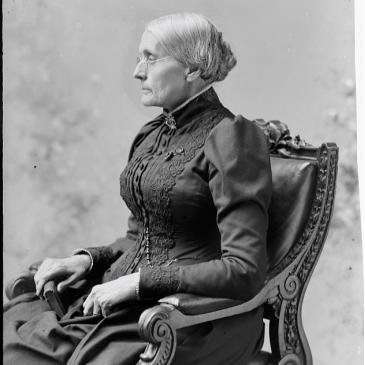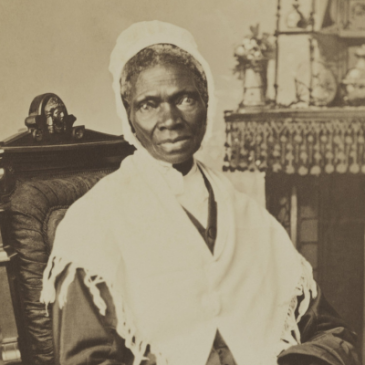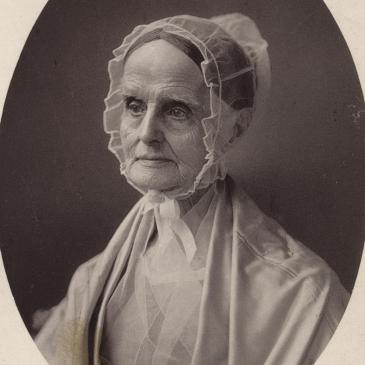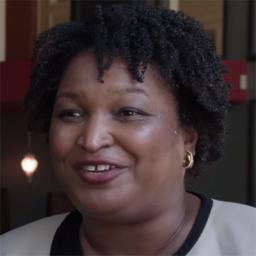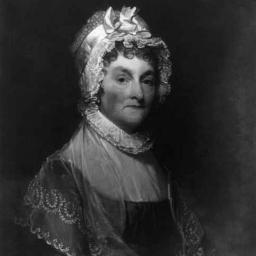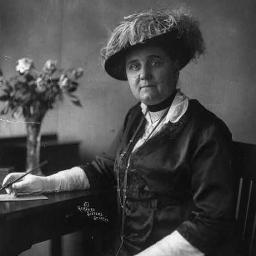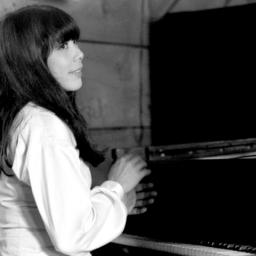Elizabeth Cady Stanton
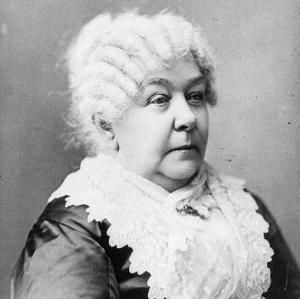
Trailblazer for Women’s Rights
Elizabeth Cady Stanton co-founded the first Women’s Rights Convention in Seneca Falls and authored the groundbreaking Declaration of Sentiments, boldly demanding equal rights—including the right to vote—for women in 1848.
Powerful Partnerships
Her dynamic collaboration with Susan B. Anthony helped shape the women’s suffrage movement for over 50 years, with Stanton penning speeches and articles that Anthony delivered across the nation.
Voice of a Movement
A prolific writer and fearless thinker, Stanton challenged religious and legal norms with works like The Woman's Bible and History of Woman Suffrage, laying the intellectual foundation for future generations of feminists.
“We hold these truths to be self-evident: that all men and women are created equal.”
Declaration of Sentiments, 1848
Oh, my daughter, I wish you were a boy!
Author, lecturer, and chief philosopher of the woman’s rights and suffrage movements, Elizabeth Cady Stanton formulated the agenda for woman’s rights that guided the struggle well into the 20th century.
Born on November 12, 1815 in Johnstown, New York, Stanton was eighth of ten children born to Margaret Livingston and Daniel Cady. Cady became a state Supreme Court judge and hoped for great law careers for his five sons, four of whom died in infancy and the fifth who died when Stanton was 11 years old. She recalls her father’s grief in her memoir:
“I still recall …going into a large, darkened parlor to see my brother and finding the casket, mirrors and pictures all draped in white, and my father seated by his side, pale and immovable. As he took no notice of me, after standing a long while, I climbed upon his knee, when he mechanically put his arm about me and with my head resting against his beating heart we both sat in silence, he thinking of the wreck of all his hopes in the loss of a dear son, and I wondering what could be said or done to fill the void in his breast. At length, he heaved a deep sigh and said: ‘Oh, my daughter, I wish you were a boy!’ Throwing my arms about his neck, I replied: ‘ will try to be all my brother was.’”
Had Stanton been one of her brothers, she may have attended a university like Union College, as her brother Eleazar did before his passing. As a woman in the 1840s, when no university program in the United States admitted women, her options for formal education were much more limited. She ultimately pursued her education at the Johnstown Academy and at Emma Willard's Troy Female Seminary in New York. She gained an informal legal education from her father’s male associates and colleagues who would gather in the Cady household and discuss the pressing issues of the day.
Curious, spirited, and eager to make change in the world, as a young woman Stanton met abolitionist lecturer Henry Stanton in her cousin’s home, where he was also a guest. They soon fell in love and were engaged. Henry Stanton’s letter to Elizabeth Cady demonstrates his enthusiasm for the match and hopes for their future together:
“A happy new year to thee, my own beloved Elizabeth! I hope this bright but cold morning finds thee cheerful & brilliant as usual, and enriched with the affectionate admiration of many warm friends. But, among them all thou shall not find one who loves thee more devotedly, or would do more to render this & all thy future years ‘happy’, than him whose hand traces these lines... And where and how shall we be at the beginning of the next New Year? Will these hearts be still united, and like kindred drops, mingled into one?”
She, too, became active in the anti-slavery movement and worked alongside leading abolitionists of the day. The couple married in 1840, against her family’s wishes and refusing to use the words “to obey” in their marriage vows. They left promptly for a honeymoon in London for the World’s Anti-Slavery convention.
We hold these truths to be self-evident that all men and women are created equal.
While in London, Stanton met abolitionist Lucretia Mott at a tea party hosted by a mutual friend. Mott, like her, was angry about the exclusion of women as speakers at the World’s Anti-Slavery convention. Mott and Stanton, now fast friends, vowed to call a woman’s rights convention when they returned home to the United States Eight years later, in 1848, that dream became a reality at the first Woman’s Rights convention at Seneca Falls, New York.
At Seneca Falls, Stanton presented, “The Declaration of Sentiments,” which expanded on the Declaration of Independence by adding the word “woman” or “women” throughout. This powerful re-writing of a document of such importance from national history positions women as integral to national identity.
“We hold these truths to be self-evident; that all men and women are created equal; that they are endowed by their Creator with certain inalienable rights; that among these are life, liberty, and the pursuit of happiness; that to secure these rights governments are instituted, deriving their just powers from the consent of the governed.”
This pivotal document called for social and legal changes to elevate women’s place in society and listed 18 grievances from the inability to control their wages and property or the difficulty in gaining custody in divorce to the lack of the right to vote. Amongst many claims regarding women’s historical subjugation in American society, she singles out some of the following:
“The history of mankind is a history of repeated injuries and usurpations on the part of man toward woman, having in direct object the establishment of an absolute tyranny over her. To prove this, let facts be submitted to a candid world...
-
He has compelled her to submit to laws, in the formation of which she had no voice...
-
He has made her, if married, in the eye of the law, civilly dead...
-
He has taken from her all right in property, even to the wages she earns...
-
He has monopolized nearly all the profitable employments, and from those she is permitted to follow, she receives but a scanty remuneration...
-
He closes against her all the avenues to wealth and distinction, which he considers most honorable to himself. As a teacher of theology, medicine, or law, she is not known...
-
He has denied her the facilities for obtaining a thorough education - all colleges being closed against her...”
That same year, Stanton circulated petitions throughout New York to urge the New York Congress to pass the New York Married Women’s Property Act, which affirmed that married women could keep their own property and earn their own wages, rather than subjecting to their husband’s financial control.
In these early stages of her advocacy, Stanton had a particular focus towards the rights free, propertied, and married women of the upper-middle class, which would only grow stronger throughout her career. She wrote from the perspective that she herself understood due to her status in society yet misses the perspectives of other voices and in fact speaks out against rights for men outside of her social class such as “natives and foreigners.”
Women’s Suffrage
Although Stanton remained committed to efforts to gain property rights for married women and ending slavery, the women’s suffrage movement increasingly became her top priority. Stanton met Susan B. Anthony in 1851, and the two quickly began collaboration on speeches, articles, and books. Their intellectual and organizational partnership dominated the woman’s movement for over half a century. When Stanton was unable to travel due to the demands of raising her seven children, she would author speeches for Anthony to deliver. Together, the Stanton and Anthony founded the National Women’s League.
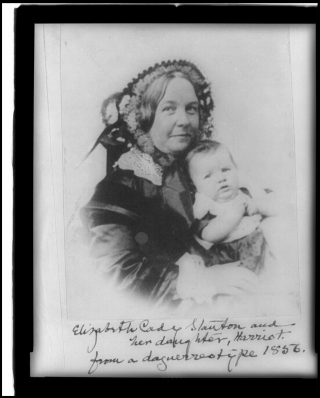
Figure 1
Elizabeth Cady Stanton and her daughter, Harriet (1856)
In 1862, Stanton and her family moved to New York City. With the nation in the middle of a Civil War, Stanton joined with Anthony to advocate for Congressional approval of the 13th Amendment, which ended slavery.
She and Anthony opposed the 14th and 15th amendments to the US Constitution, which gave voting rights to black men but did not extend the franchise to women. Their stance led to a rift with other women’s suffragists and prompted Stanton and Anthony to found the National Woman Suffrage Association (NWSA) in 1869. Stanton edited and wrote for NWSA’s journal The Revolution. As NWSA president, Stanton was an outspoken social and political commentator and debated the major political and legal questions of the day. The NWSA and the American Woman Suffrage Association reunited in 1890 as the National American Woman’s Suffrage Association.
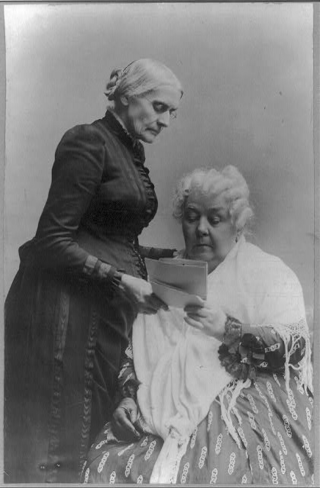
Figure 2
Elizabeth Cady Stanton seated, reading with Susan B. Anthony
Self-development is a higher duty than self-sacrifice.
An outstanding orator with a sharp mind, Stanton was able to travel more after her children were older and she became one of the best-known women’s rights activists in the country. Her speeches addressed such topics as maternity, child rearing, divorce law, married women’s property rights, temperance, abolition, and presidential campaigns.
The importance of self-determination and intellectual development for women’s own health and happiness shines through in her speeches, as explored in this excerpt from “Our Girls” (1872), which was one of Stanton’s most popular that she delivered around the nation:
“These boys and girls are one to-day in school, at play, at home, never dreaming that one sex was foreordained to clutch the stars, the other but to kiss the dust...And why? They have awakened to the fact that they belong to a subject, degraded, ostracised class: that to fulfill their man appointed sphere, they can have no individual character, no life purpose, personal freedom, aim or ambition. They are simply to revolve round some man, to live only for him, in him, with him, to be fed, clothed, housed, guided and controlled by him, to-day by Father or Brother, tomorrow by Husband or Son, no matter how wise or mature, they are never to know the freedom and dignity that one secures in self-dependence and self support.”
The Woman’s Bible
By the 1880s, Stanton was 65 years old and focused more on writing rather than traveling and lecturing. She wrote three volumes of the History of Woman Suffrage (1881–85) with Anthony and Matilda Joslyn Gage. In this comprehensive work, published several decades before women won the right to vote, the authors documented the individual and local activism that built and sustained a movement for woman suffrage. Along with numerous articles on the subject of women and religion, Stanton published the Woman’s Bible (1895, 1898), in which she voiced her belief in a secular state and urged women to recognize how religious orthodoxy and male-centric theology impaired their ability to achieve equality. She writes regarding the Genesis creation story, arguing for the biblical equality of men and women:
“Thus, the old Testament, ‘in the beginning,’ proclaims the simultaneous creation of man and woman, the eternity and equality of sex; and the new Testament echoes back through the centuries the individual sovereignty of women, growing out of this natural fact. Paul, in speaking of equality as the very soul and essence of Christianity, said, ‘There is neither Jew nor Greek, there is neither bond nor free, there is neither male nor female; for ye are all one in Christ Jesus.’ With this recognition of the feminine element in the Godhead in the Old Testament, and this declaration off the equality of the sexes in the New, we may well wonder at the contemptible status woman occupies in the Christian Church of to-day.”
She recorded her memories in an autobiography, Eighty Years and More, which gives insight into her mind as well as the great events and work of her life. Stanton died in October 1902 in New York City, 18 years before women of Stanton’s social status gained the right to vote.
Stanton was a controversial figure in her own lifetime and afterwards, as a person in the public eye who lived a long life, saw many societal changes, and advocated for even more. Her writings were her focal point of expression, yet she often contradicted herself as the world around her became more modern and regressed into the past for nearly a century.
Click here to watch this video for more on Elizabeth Cady Stanton.
 Primary Source Analysis Strategies
Primary Source Analysis Strategies
Letter from Henry Brewster Stanton to Elizabeth Cady when they were first engaged to be married.
-
Are there any words or references that you do not understand in this source? How could you find the context to enhance your understanding? Can you read any of the writing without the transcript?
-
What is the poem that Stanton quotes? What feelings does it express towards Cady?
-
How would you feel to receive a letter like this from someone you loved?
Elizabeth Cady Stanton, “Our Girls” (Winter 1880)
-
What are the argumentative strategies that Stanton is using in this speech? Are they convincing?
-
How is Stanton describing the world she lived in through this speech? What can you understand about her life and times from reading it?
-
Do you relate to any of the images and ideas she discusses in the speech?
Elizabeth Cady Stanton, Handwritten Draft of The Woman’s Bible
-
What text is Stanton referencing in these notes? Are you familiar with it? Why would Stanton choose to annotate this text in particular?
-
What sources and argumentative strategies is Stanton using to prove her point?
-
How does this source reflect Stanton’s ideas about the status of women at her time?
Alma Lutz, “Elizabeth Cady Stanton,” in Edward T. James, Janet Wilson James, and Paul Boyer, editors, Notable American Women, 1607-1950: A Biographical Dictionary (Cambridge: Belknap Press of Harvard University, 1971), p. 342-347.
Banner, Lois W. Elizabeth Cady Stanton: A Radical for Women's Rights (Longman, 1997).
Bohannon, Lisa Frederiksen. Women's Rights and Nothing Less: The Story of Elizabeth Cady Stanton (Morgan Reynolds Publishing, 2000).
Burgan, Michael. Elizabeth Cady Stanton: Social Reformer (Compass Point Books, 2005). -- ages 9-12.
Clarke, Mary Stetson. Bloomers and Ballots: Elizabeth Cady Stanton and Women's Rights (NY: Viking, 1972).
Davis, Lucile. Elizabeth Cady Stanton: A Photo-Illustrated Biography (Capstone Press, 1998). -- for ages 4-8
Dubois, Ellen Carol. The Elizabeth Cady Stanton-Susan B. Anthony Reader: Correspondences, Writings, Speeches (Boston: Northeastern University Press, 1992).
“Elizabeth Cady Stanton,” nps.gov. National Park Service accessed May 21, 2025. nps.gov/people/elizabeth-cady-stanton.htm
Griffith, Elisabeth. In Her Own Right: The Life of Elizabeth Cady Stanton (Oxford: Oxford University Press, 1985).
“Life and Times,” Elizabethcadystanton.org. Elizabeth Cady Stanton Trust, 2025. Accessed May 21, 2025. elizabethcadystanton.org/mrs-stanton/life-times
Mace, Emily R. “Feminist Forerunners and a Usable Past: A Historiography of Elizabeth Cady Stanton’s The Woman’s Bible.” Journal of Feminist Studies in Religion 25, no. 2 (December 31, 2009): 5–23.
Pellauer, Mary D. Toward a Tradition of Feminist Theology: The Religious Social Thought of Elizabeth Cady Stanton, Susan B. Anthony, and Anna Howard Shaw (Carlson Pub., 1991).
Salisbury, Cynthia. Elizabeth Cady Stanton: Leader of the Fight for Women's Rights (Enslow Publisher, 2002).—for ages 9-12.
Sigerman, Harriet. Elizabeth Cady Stanton: The Right is Ours (Oxford: Oxford University Press, 2001).
Stanton, Elizabeth Cady. Eighty Years and More (1815-1897); Reminiscences of Elizabeth Cady Stanton (1898).
Stanton, Elizabeth Cady. Elizabeth Cady Stanton: As Revealed in Her Letters, Diary and Reminiscences (Ayer Co. Pub., 1977).
Stanton, Elizabeth Cady. The Selected Papers of Elizabeth Cady Stanton and Susan B. Anthony: In the School of Anti-Slavery, 1840-1866 (Rutgers: Rutgers University Press, 1997).
Vetter, Lisa Pace. “Elizabeth Cady Stanton and Lucretia Mott: Radical ‘Co-Adjutors’ in the American Women’s Rights Movement.” British Journal for the History of Philosophy 29, no. 2 (March 1, 2021): 244–58.
Waggenspack, Beth M. The Search for Sovereignty: The Oratory of Elizabeth Cady Stanton (Greenwood Press, 1989).
Wellman, Judith. The Road to Senecca Falls: Elizabeth Cady Stanton and the First Woman's Rights Convention(Urbana: University of Illinois Press, 2004).
MLA – McKelvie, Lydia. “Elizabeth Cady Stanton.” National Women’s History Museum, 2025. Date accessed.
Chicago – McKelvie, Lydia. “Elizabeth Cady Stanton.” National Women’s History Museum. 2025. Link.
Books
- Adiletta, Dawn C. Elizabeth Cady Stanton: Woman Suffrage and the First Vote (PowerPlus Books, 2005) - for ages 4-8.
- Banner, Lois W. Elizabeth Cady Stanton: A Radical for Women's Rights (Longman, 1997).
- Bohannon, Lisa Frederiksen. Women's Rights and Nothing Less: The Story of Elizabeth Cady Stanton (Morgan Reynolds Publishing, 2000).
- Burgan, Michael. Elizabeth Cady Stanton: Social Reformer (Compass Point Books, 2005). -- ages 9-12.
- Clarke, Mary Stetson. Bloomers and Ballots: Elizabeth Cady Stanton and Women's Rights (NY: Viking, 1972).
- Davis, Lucile. Elizabeth Cady Stanton: A Photo-Illustrated Biography (Capstone Press, 1998). -- for ages 4-8
- Dubois, Ellen Carol. The Elizabeth Cady Stanton-Susan B. Anthony Reader: Correspondences, Writings, Speeches (Boston: Northeastern University Press, 1992).
- Griffith, Elisabeth. In Her Own Right: The Life of Elizabeth Cady Stanton (Oxford: Oxford University Press, 1985).
- Pellauer, Mary D. Toward a Tradition of Feminist Theology: The Religious Social Thought of Elizabeth Cady Stanton, Susan B. Anthony, and Anna Howard Shaw (Carlson Pub., 1991).
- Salisbury, Cynthia. Elizabeth Cady Stanton: Leader of the Fight for Women's Rights (Enslow Publisher, 2002). -- for ages 9-12.
- Sigerman, Harriet. Elizabeth Cady Stanton: The Right is Ours (Oxford: Oxford University Press, 2001).
- Stanton, Elizabeth Cady. Eighty Years and More (1815-1897); Reminiscences of Elizabeth Cady Stanton (1898).
- Stanton, Elizabeth Cady. Elizabeth Cady Stanton: As Revealed in Her Letters, Diary and Reminiscences (Ayer Co. Pub., 1977).
- Stanton, Elizabeth Cady. The Selected Papers of Elizabeth Cady Stanton and Susan B. Anthony: In the School of Anti-Slavery, 1840-1866 (Rutgers: Rutgers University Press, 1997).
- Waggenspack, Beth M. The Search for Sovereignty: The Oratory of Elizabeth Cady Stanton (Greenwood Press, 1989).
- Wellman, Judith. The Road to Senecca Falls: Elizabeth Cady Stanton and the First Woman's Rights Convention(Urbana: University of Illinois Press, 2004).
Websites
- America’s Library
- National Women's Hall of Fame
- Papers of Elizabeth Cady Stanton and Susan B. Anthony Project
- Public Broadcasting System (PBS) “Not For Ourselves Alone: The Story of Elizabeth Cady Stanton and Susan B. Anthony”
- Quotes of Elizabeth Cady Stanton
- Stanton's speech at the Women's Rights Conference in 1848
- University of Rochester
- npr.org/2011/07/13/137681070/for-stanton-all-women-were-not-created-equal
- Library of Congress: Votes for Women: the National American Woman Suffrage Association Collection, 1848-1921.
Videos
Susan B. Anthony

This biography is sponsored in part by the Library of Congress Teaching with Primary Sources Eastern Region Program, coordinated by Waynesburg University. Content created and featured in partnership with the TPS program does not indicate an endorsement by the Library of Congress.
For further information or questions, please contact [email protected].

